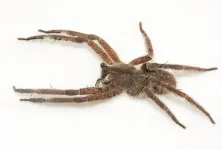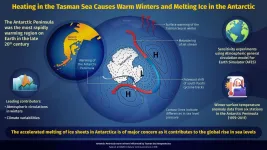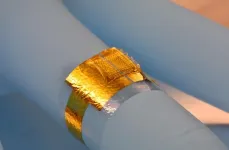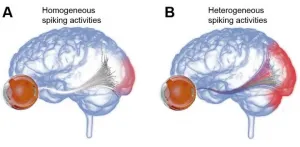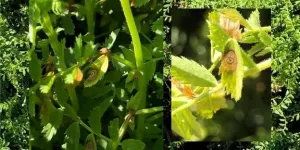(Press-News.org) Spiders from the genus Phoneutria - also known as banana spiders - are considered aggressive and among the most venomous spiders in the world, with venom that has a neurotoxic action. These large nocturnal spiders usually inhabit environments disturbed by humans and are often found in banana plantations in the Neotropical region.
One of these spiders, P. boliviensis, is a medically important species widely distributed in Central and South America, whose behaviour, habitat, venom composition, toxicity and bites on humans have already been paid considerable attention in previous research work. Nevertheless, after examining a large pool of museum specimens, biologists from The George Washington University (N. Hazzi and G. Hormiga) began to wonder if samples named P. boliviensis were actually belonging to one and the same species.
Everything started when N. Hazzi was examining specimens of banana spiders identified in the past by experts as P. boliviensis. The research team quickly realized that the morphological features currently used to identify this species were not sufficient. Then, they discovered two well-defined morphological groups of P. boliviensis that were separated by the Andean mountain range, a geographic barrier that separates many other species.
To prove that these two "forms" were different species, the authors conducted fieldwork in the Amazon, Andes, and Central America, collecting specimens of these venomous spiders to explore if the genomic signal also suggests two species. They discovered that genetic differences separating these two forms were similar compared to the genetic differences separating other recognized species of banana spiders. Using morphological, genomic and geographic distribution data, the authors concluded that P. boliviensis represents not a single species, but two different ones. They uncovered that the true P. boliviensis was only found in the Amazonian region, and the second species, P. depilata (an old name revalidated by the research team), was found in the Andes, Chocó and Caribbean regions. Their findings are published in the open-access, peer-reviewed journal ZooKeys.
To obtain more distribution records for these species, the research team used the citizen science platform iNaturalist. Since the two species are among the few spiders that can be identified using only images, the platform turned out to be a very helpful tool. Data submitted by the iNaturalist community helped identify where the two species of Phoneutria are found. Curiously enough, for these two species, iNaturalist presented higher and more widely distributed records than the scientists' own database.
"To our knowledge, this is the first study that has used iNaturalist to gather occurrence records on venomous species to estimate distribution models," the researchers say.
This is how the two spiders can be distinguished using only photographs: P. boliviensis has two lateral white-yellow bands in the anterior area of the carapace, while P. depilata has four series of yellow dots in the ventral side of the abdomen. In addition, for P. depilata's identification, information is needed on where the image was taken, because this is the only species of Phoneutria found in the Andes, Chocó, and Central America. However, the most reliable approach to identify these species requires examination under a stereomicroscope.
Interestingly, P. depilata has been mislabeled as P. boliviensis throughout many studies, including works on venom composition and toxicity, ecology, geographic distribution, and human epidemiology of bites. There have been human bite records of this species reported in Costa Rica and in banana plantations in Colombia, most of them with mild to moderate envenomation symptoms. Except for brief anecdotal mentions by field explorers in the Amazon, little is known about P. depilata.
The study provides detailed diagnoses with images to distinguish both species and distribution maps.
"This valuable information will help identify risk areas of accidental bites and assist health professionals in determining the identity of the species involved, especially for P. depilata. This is a significant discovery that will affect studies about toxicology, opening new opportunities to compare the venom composition and the effect of these two species," the authors conclude.
INFORMATION:
Research article:
Hazzi NA, Hormiga G (2021) Morphological and molecular evidence support the taxonomic separation of the medically important Neotropical spiders Phoneutria depilata (Strand, 1909) and P. boliviensis (F.O. Pickard-Cambridge, 1897) (Araneae, Ctenidae). ZooKeys 1022: 13-50. https://doi.org/10.3897/zookeys.1022.60571
Corresponding authors:
Nicolas A. Hazzi
Email: nicolashazzi@gwu.edu
https://www.researchgate.net/profile/Nicolas-Hazzi
Gustavo Hormiga
Email: hormiga@gwu.edu
https://biology.columbian.gwu.edu/gustavo-hormiga
Tsukuba, Japan - Because human females have two X chromosomes and males have one X and one Y, somatic cells have special mechanisms that keep expression levels of genes on the X chromosome the same between both sexes. This process is called dosage compensation and has been extensively studied in the fruit fly Drosophila. Now, researchers at the University of Tsukuba (UT) continued work with Drosophila to show that dosage compensation does not occur in the germ cells of male flies.
In an article published in Scientific Reports, the UT researchers investigated this phenomenon in fly primordial germ cells (PGCs), which are present in embryos and are the precursor cells to what ultimately become ...
Pierfranco Demontis said in 1988, "Ice becomes a fast-ion conductor at high pressure and high temperatures," but his prediction was only hypothetical until recently. After 30 years of study, superionic water ice was verified experimentally in 2018. Superionicity may eventually explain the strong magnetic field in giant planetary interiors.
What about Earth, whose interiors are also under extreme pressure and temperature conditions? Although three-quarters of Earth's surface is covered by water, standalone water or ice rarely exists in Earth's interiors. The most common unit of "water" is hydroxyl, which is associated with host minerals to make ...
The melting of the Earth's ice cover intensified in the 20th century, with glaciers and sea ice in the Arctic and Antarctic regions melting at alarming speeds. In fact, The Antarctic Peninsula (AP), which is the only landmass of Antarctica extending out past the Antarctic Circle, was found to be one of the most rapidly warming regions on the planet during the second half of the 20th century. This rapid change in climate has raised serious concerns of rising sea levels the world over.
Multiple factors have been associated with the melting of the ice cover: the primary factor being the greenhouse gas emissions from human activities that cause ...
Anxiety levels in the United States are rising sharply and have especially intensified in younger populations. According to the Anxiety and Depression Association of America, anxiety disorders affect 31.9 percent of children ages 13 to 18 years old. Because of the COVID-19 pandemic, children and adolescents have experienced unprecedented interruptions to their daily lives and it is expected that these disruptions may precipitate mental illness, including anxiety, depression, and/or stress related symptoms.
Traditional anxiety and depression treatments include ...
A critical ingredient for auroras exists much higher in space than previously thought, according to new research in the journal Scientific Reports. The dazzling light displays in the polar night skies require an electric accelerator to propel charged particles down through the atmosphere. Scientists at Nagoya University and colleagues in Japan, Taiwan and the US have found that it exists beyond 30,000 kilometres above the Earth's surface - offering insight not just about Earth, but other planets as well.
The story of aurora formation begins with supersonic plasma propelled from the Sun into space as high-speed, charged particles. When these charged particles get close to Earth, they are ...
Scientists at the University of Virginia School of Medicine have developed a tool to monitor communications within the brain in a way never before possible, and it has already offered an explanation for why Alzheimer's drugs have limited effectiveness and why patients get much worse after going off of them.
The researchers expect their new method will have tremendous impact on our understanding of depression, sleep disorders, autism, neurological diseases and major psychiatric conditions. It will speed scientific research into the workings of the brain, they say, and facilitate the development of new treatments.
"We can now 'see' how brain cells communicate in sharp detail in both the healthy and diseased brains," said lead researcher J. Julius Zhu, PhD, of UVA's Department ...
(LOS ANGELES) - Recent advances in technology have opened many possibilities for using wearable and implantable sensors to monitor various indicators of patient health. Wearable pressure sensors are designed to respond to very small changes in bodily pressure, so that physical functions such as pulse rate, blood pressure, breathing rates and even subtle changes in vocal cord vibrations can be monitored in real time with a high degree of sensitivity.
Such responses occur when a substance in the sensor "gates," or allows selected pressure signals to pass to a transistor, which then conducts and amplifies these signals for detection. A recent type of transistor, organic electrochemical transistors ...
Visual sensation begins at the retina, which is the neural tissue located at the back of eyeballs. It has been known that the retina detects light using photoreceptors which are light-sensitive nerve cells.In case of retinal degenerative diseases such as retinitis pigmentosa and age-related macular degeneration, those light sensing neurons are gradually damaged, leading to a profound vision loss. At this moment, no cure is available for the abovementioned ailments. But, microelectronic retinal prostheses can create artificial vision by electrically stimulating remaining retinal neurons although the prosthetic vision is still far removed from normal vision.
To further improve the quality of prosthetic artificial vision, Dr. Maesoon ...
A staple for many, chickpeas are a rich source of vitamins, minerals, and fiber and offer many health benefits, such as improving digestion and reducing the risk of ailments including heart disease and cancer. However, chickpeas possess a rather narrow genetic diversity and are susceptible to Ascochyta blight, a devastating disease that can cause a yield loss of up to 100 percent. In Australia alone, this disease costs an average of $4.8 million annually.
To help curtail the impact of Ascochyta blight, plant pathologists in Western Australia have turned to wild relatives of the ...
In the spring of 2020, the outbreak of the coronavirus pandemic appeared to coincide with the tree pollen season in the northern hemisphere. These observations prompted an international team of researchers to conduct an extensive investigation: The scientists wanted to know whether there is a demonstrable link between airborne pollen concentrations and SARS-CoV-2 infection rates.
Pollen is a significant environmental factor influencing infection rates
Under the leadership of first author Athanasios Damialis, the team at the Chair of Environmental Medicine at TUM collected data on airborne pollen concentrations, weather conditions and SARS-CoV-2 infections - taking into consideration the variation of infection rates from ...
